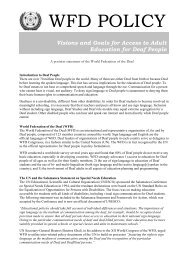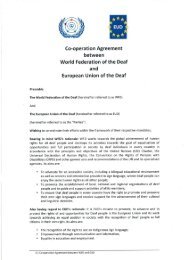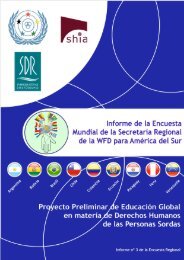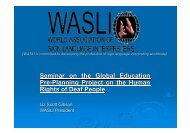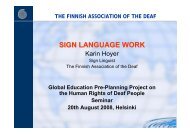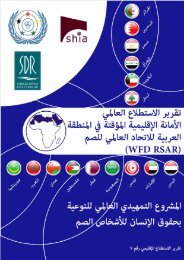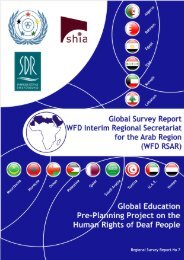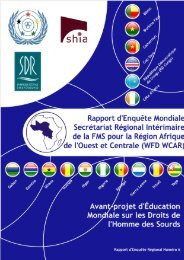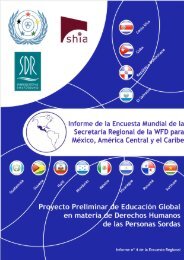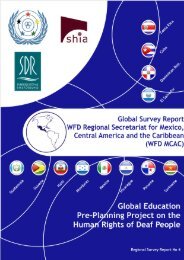Perspectives on the concept and definition of International Sign, Dr
Perspectives on the concept and definition of International Sign, Dr
Perspectives on the concept and definition of International Sign, Dr
Create successful ePaper yourself
Turn your PDF publications into a flip-book with our unique Google optimized e-Paper software.
<str<strong>on</strong>g>Perspectives</str<strong>on</strong>g> <strong>on</strong> <strong>the</strong> C<strong>on</strong>cept <strong>and</strong><br />
Definiti<strong>on</strong> <strong>of</strong> Internati<strong>on</strong>al <strong>Sign</strong><br />
<strong>Dr</strong>. Johanna Mesch<br />
World Federati<strong>on</strong> <strong>of</strong> <strong>the</strong> Deaf<br />
May 2010
<str<strong>on</strong>g>Perspectives</str<strong>on</strong>g> <strong>on</strong> <strong>the</strong> C<strong>on</strong>cept <strong>and</strong> Definiti<strong>on</strong> <strong>of</strong> Internati<strong>on</strong>al <strong>Sign</strong> 2010<br />
<str<strong>on</strong>g>Perspectives</str<strong>on</strong>g> <strong>on</strong> <strong>the</strong> C<strong>on</strong>cept <strong>and</strong> Definiti<strong>on</strong> <strong>of</strong> Internati<strong>on</strong>al <strong>Sign</strong><br />
Compiled by<br />
<strong>Dr</strong> Johanna Mesch<br />
World Federati<strong>on</strong> <strong>of</strong> <strong>the</strong> Deaf<br />
May 2010<br />
Please c<strong>on</strong>tact:<br />
General Secretariat<br />
World Federati<strong>on</strong> <strong>of</strong> <strong>the</strong> Deaf<br />
PO Box 65<br />
FIN-00401<br />
Helsinki, Finl<strong>and</strong><br />
Email: info@wfdeaf.org<br />
Website: www.wfdeaf.org<br />
Fr<strong>on</strong>t Page Cover Designer: Colin Allen<br />
Photo Credits: Colin Allen<br />
© Copyright by <strong>the</strong> World Federati<strong>on</strong> <strong>of</strong> <strong>the</strong> Deaf<br />
All rights reserved. When referring to or quoting any part <strong>of</strong> <strong>the</strong> report it is required that <strong>the</strong> publisher <strong>and</strong><br />
<strong>the</strong> original publicati<strong>on</strong> be menti<strong>on</strong>ed in <strong>the</strong> following form: ‘<str<strong>on</strong>g>Perspectives</str<strong>on</strong>g> <strong>on</strong> <strong>the</strong> C<strong>on</strong>cept <strong>and</strong> Definiti<strong>on</strong> <strong>of</strong><br />
Internati<strong>on</strong>al <strong>Sign</strong>’, by <strong>Dr</strong>. Johanna Mesch for <strong>the</strong> World Federati<strong>on</strong> <strong>of</strong> <strong>the</strong> Deaf, 2010.<br />
ISBN 978-952-9648-22-1<br />
1 | P a g e
Table <strong>of</strong> C<strong>on</strong>tents<br />
<str<strong>on</strong>g>Perspectives</str<strong>on</strong>g> <strong>on</strong> <strong>the</strong> C<strong>on</strong>cept <strong>and</strong> Definiti<strong>on</strong> <strong>of</strong> Internati<strong>on</strong>al <strong>Sign</strong> 2010<br />
1. Foreword 3<br />
2. Introducti<strong>on</strong> 4<br />
3. Definiti<strong>on</strong> <strong>of</strong> Internati<strong>on</strong>al <strong>Sign</strong> 5<br />
4. The vocabulary <strong>and</strong> grammar <strong>of</strong> Internati<strong>on</strong>al <strong>Sign</strong> 6<br />
5. Pidgin or Creole? 7<br />
6. Transmitted informati<strong>on</strong> with Internati<strong>on</strong>al <strong>Sign</strong> 8<br />
7. About teaching <strong>and</strong> learning Internati<strong>on</strong>al <strong>Sign</strong> 9<br />
8. Some thoughts comparing American <strong>Sign</strong> Language <strong>and</strong><br />
Internati<strong>on</strong>al <strong>Sign</strong> as lingua franca 10<br />
9. C<strong>on</strong>clusi<strong>on</strong>s 11<br />
10. References 12<br />
11. Appendix 13<br />
2 | P a g e
1. Foreword<br />
<str<strong>on</strong>g>Perspectives</str<strong>on</strong>g> <strong>on</strong> <strong>the</strong> C<strong>on</strong>cept <strong>and</strong> Definiti<strong>on</strong> <strong>of</strong> Internati<strong>on</strong>al <strong>Sign</strong> 2010<br />
During <strong>the</strong> discussi<strong>on</strong> at <strong>the</strong> General Assembly (GA) <strong>of</strong> <strong>the</strong> World Federati<strong>on</strong> <strong>of</strong> <strong>the</strong> Deaf (WFD) in<br />
M<strong>on</strong>treal 2003, several countries challenged <strong>the</strong> use <strong>of</strong> ‟Internati<strong>on</strong>al <strong>Sign</strong> Language‟. Some countries<br />
argued that more research was needed before it could be regarded as a language. There was a clear<br />
divisi<strong>on</strong> between delegates who supported <strong>the</strong> use <strong>of</strong> <strong>the</strong> term “language” <strong>and</strong> those who did not. The<br />
GA voted 20-15, with five (5) abstenti<strong>on</strong>s, in favour <strong>of</strong> using <strong>the</strong> term „Internati<strong>on</strong>al <strong>Sign</strong>‟.<br />
According to a decisi<strong>on</strong> <strong>of</strong> <strong>the</strong> Board <strong>of</strong> WFD, January 2007, Mr Tomas Hedberg <strong>and</strong> <strong>Dr</strong> Joseph Murray<br />
were commissi<strong>on</strong>ed to make a questi<strong>on</strong>naire, c<strong>on</strong>duct a survey <strong>and</strong> to work with WFD Experts <strong>on</strong> <strong>Sign</strong><br />
Language during <strong>the</strong> Spring <strong>of</strong> 2007 to follow up <strong>on</strong> <strong>the</strong> request to come to an agreement regarding <strong>the</strong><br />
term Internati<strong>on</strong>al <strong>Sign</strong>. Preliminary survey results <strong>on</strong> Internati<strong>on</strong>al <strong>Sign</strong> (IS) were presented by Tomas<br />
Hedberg at a workshop before <strong>the</strong> GA in Madrid Summer 2007. It turned out that a majority <strong>of</strong> <strong>the</strong><br />
delegates recommended that <strong>the</strong> term IS be used. In c<strong>on</strong>necti<strong>on</strong> with a revisi<strong>on</strong> <strong>of</strong> <strong>the</strong> statutes <strong>of</strong> WFD,<br />
it had also been decided to put in <strong>the</strong> term IS in <strong>the</strong> statutes <strong>and</strong> to use <strong>the</strong> term IS for general <strong>and</strong><br />
<strong>of</strong>ficial meetings.<br />
In October 2007 it was decided that <strong>the</strong>re would be a written report <strong>of</strong> <strong>the</strong> survey. <strong>Dr</strong> Johanna Mesch<br />
was willing to make a compilati<strong>on</strong> <strong>of</strong> <strong>the</strong> survey results <strong>on</strong> Internati<strong>on</strong>al <strong>Sign</strong> during 2009.<br />
WFD would like to thank <strong>the</strong> following people: Mr Tomas Hedberg <strong>and</strong> <strong>Dr</strong> Joseph Murray, WFD Board<br />
members, for <strong>the</strong>ir implementati<strong>on</strong> <strong>of</strong> a survey <strong>of</strong> <strong>the</strong> c<strong>on</strong>cept <strong>of</strong> IS; <strong>Dr</strong> Johanna Mesch for her work<br />
with <strong>the</strong> compilati<strong>on</strong> <strong>of</strong> <strong>the</strong> survey results <strong>on</strong> IS <strong>and</strong> Mr Colin Allen for his voluntary work <strong>on</strong> <strong>the</strong> layout.<br />
The report was also sent to <strong>the</strong> WFD <strong>Sign</strong> Language Experts for <strong>the</strong>ir comments. WFD also would like to<br />
thank Robert Adam, Karin Hoyer, Verena Krausneker, Sam Lutalo <strong>and</strong> Mats J<strong>on</strong>ss<strong>on</strong> for <strong>the</strong>ir comments<br />
during April 2010. Finally WFD would also like to thank 20 sign language researchers <strong>and</strong> interpreters<br />
who voluntarily answered questi<strong>on</strong>s <strong>and</strong> c<strong>on</strong>tributed <strong>the</strong>ir views <strong>on</strong> <strong>the</strong> c<strong>on</strong>cept <strong>of</strong> IS during <strong>the</strong> Spring<br />
<strong>of</strong> 2007. Their resp<strong>on</strong>ses were very valuable for <strong>the</strong> WFD.<br />
Markku Jokinen<br />
WFD President<br />
3 | P a g e
2. Introducti<strong>on</strong><br />
<str<strong>on</strong>g>Perspectives</str<strong>on</strong>g> <strong>on</strong> <strong>the</strong> C<strong>on</strong>cept <strong>and</strong> Definiti<strong>on</strong> <strong>of</strong> Internati<strong>on</strong>al <strong>Sign</strong> 2010<br />
Internati<strong>on</strong>al <strong>Sign</strong> (IS) is comm<strong>on</strong>ly used at <strong>the</strong> General Assembly (GA) <strong>of</strong> <strong>the</strong> World Federati<strong>on</strong> <strong>of</strong> <strong>the</strong><br />
Deaf (WFD) <strong>and</strong> <strong>of</strong> <strong>the</strong> Internati<strong>on</strong>al Committee <strong>of</strong> Sports for <strong>the</strong> Deaf, <strong>and</strong> also in many o<strong>the</strong>r<br />
internati<strong>on</strong>al meetings <strong>and</strong> events. The status <strong>of</strong> Internati<strong>on</strong>al <strong>Sign</strong> as a language has been debated for<br />
a l<strong>on</strong>g time due to its flexibility <strong>and</strong> possibilities as a communicati<strong>on</strong> system. A dicti<strong>on</strong>ary <strong>of</strong> Gestuno<br />
(The British Associati<strong>on</strong> <strong>of</strong> <strong>the</strong> Deaf 1975) was published for use in internati<strong>on</strong>al communicati<strong>on</strong>,<br />
especially for c<strong>on</strong>ferences. It had a limited vocabulary, <strong>and</strong> did not include any grammar. The system<br />
<strong>of</strong> Gestuno itself is no l<strong>on</strong>ger used to communicate. Internati<strong>on</strong>al <strong>Sign</strong> Language (ISL) is <strong>the</strong> o<strong>the</strong>r most<br />
used term. Today, <strong>the</strong> term Internati<strong>on</strong>al <strong>Sign</strong> (IS) is preferred because IS varies depending <strong>on</strong> <strong>the</strong><br />
language background <strong>of</strong> <strong>the</strong> signers who use it.<br />
Studies <strong>on</strong> internati<strong>on</strong>al communicati<strong>on</strong> in sign language <strong>and</strong> interpreting in internati<strong>on</strong>al meetings <strong>and</strong><br />
events have shown that grammatical features <strong>of</strong> IS are highly complex <strong>and</strong> make use <strong>of</strong> <strong>the</strong> same<br />
structures that natural sign languages share (e.g. Bergmann 1990, Woll 1990, Allsop, Woll & Brauti<br />
1994, Webb & Supalla 1994, Supalla <strong>and</strong> Webb 1995, Moody 2002, Locker McKee <strong>and</strong> Napier 2002,<br />
Rosenstock 2004, 2005). Still some researchers have argued that more research is needed especially <strong>on</strong><br />
face-to-face communicati<strong>on</strong> <strong>and</strong> describing IS in different parts <strong>of</strong> <strong>the</strong> world. Following hesitati<strong>on</strong>s<br />
regarding usage <strong>of</strong> <strong>the</strong> terms in <strong>of</strong>ficial presentati<strong>on</strong>s, WFD decided to c<strong>on</strong>duct a survey. According to a<br />
decisi<strong>on</strong> from <strong>the</strong> Board <strong>of</strong> WFD, Tomas Hedberg <strong>and</strong> Joseph Murray were commissi<strong>on</strong>ed to work with<br />
WFD experts in <strong>Sign</strong> Language to follow up <strong>on</strong> <strong>the</strong> request to come to an agreement regarding <strong>the</strong> term<br />
IS.<br />
A questi<strong>on</strong>naire <strong>of</strong> 16 questi<strong>on</strong>s (see Appendix 1) was sent out to WFD experts in <strong>Sign</strong> Language, sign<br />
linguists <strong>and</strong> interpreters in <strong>the</strong> World Associati<strong>on</strong> <strong>of</strong> <strong>Sign</strong> Language Interpreters (WASLI) in 16 countries<br />
during Spring 2007. Resp<strong>on</strong>ses to <strong>the</strong> survey questi<strong>on</strong>naire were received from 24 <strong>of</strong> 35 resp<strong>on</strong>dents in<br />
12 countries; Australia, Brazil, Finl<strong>and</strong>, Denmark, Germany, Italy, Japan, Ne<strong>the</strong>rl<strong>and</strong>s, New Zeal<strong>and</strong>,<br />
Sweden, United Kingdom <strong>and</strong> USA. Some interpreters from South Africa <strong>and</strong> Kenya were involved<br />
through WASLI.<br />
Seven (7/24) are Deaf linguists or work with sign language. Three (3/20) answered that <strong>the</strong><br />
questi<strong>on</strong>naire was not easy to answer. Questi<strong>on</strong> No 10 was not clear to most <strong>of</strong> <strong>the</strong> resp<strong>on</strong>dents.<br />
Four (4/24) sent feedback that <strong>the</strong>y could not resp<strong>on</strong>d to some <strong>of</strong> <strong>the</strong> questi<strong>on</strong>s, because <strong>the</strong>ir<br />
experience <strong>of</strong> IS/ISL was too limited, or <strong>the</strong> questi<strong>on</strong>s were too huge, or not very clear. One linguist<br />
argued that “There are some assumpti<strong>on</strong>s in <strong>the</strong> questi<strong>on</strong>s <strong>the</strong>mselves about what 'a language' is that<br />
would need to be picked apart by some<strong>on</strong>e who really wants to try <strong>and</strong> answer.”<br />
4 | P a g e
3. Definiti<strong>on</strong> <strong>of</strong> Internati<strong>on</strong>al <strong>Sign</strong><br />
<str<strong>on</strong>g>Perspectives</str<strong>on</strong>g> <strong>on</strong> <strong>the</strong> C<strong>on</strong>cept <strong>and</strong> Definiti<strong>on</strong> <strong>of</strong> Internati<strong>on</strong>al <strong>Sign</strong> 2010<br />
All resp<strong>on</strong>dents have various definiti<strong>on</strong>s <strong>of</strong> IS <strong>and</strong> various opini<strong>on</strong>s about whe<strong>the</strong>r it is a language or<br />
not. There is a distincti<strong>on</strong> between IS within a group who meets regularly <strong>and</strong> IS as cross-sign<br />
communicati<strong>on</strong> (ad hoc signing) with people who d<strong>on</strong>‟t know o<strong>the</strong>r sign languages or IS. Anyway, <strong>the</strong><br />
degree <strong>of</strong> c<strong>on</strong>venti<strong>on</strong>alisati<strong>on</strong> is critical to <strong>the</strong> status <strong>of</strong> IS as a language.<br />
Below are some selected important quotati<strong>on</strong>s from <strong>the</strong> survey resp<strong>on</strong>ses:<br />
This applies to <strong>the</strong> form <strong>of</strong> internati<strong>on</strong>al signing that is used by people with regular exposure to<br />
internati<strong>on</strong>al-level meetings.<br />
It is a form <strong>of</strong> c<strong>on</strong>tact signing.<br />
It fulfils all criteria <strong>of</strong> human language (design features <strong>of</strong> language as in Hockett 1966).<br />
It has a sufficiently high level <strong>of</strong> c<strong>on</strong>venti<strong>on</strong>alisati<strong>on</strong>. The level <strong>of</strong> c<strong>on</strong>venti<strong>on</strong>alisati<strong>on</strong> is lower<br />
than in nati<strong>on</strong>al sign languages, but higher than in o<strong>the</strong>r kinds <strong>of</strong> cross-sign communicati<strong>on</strong>.<br />
Fluent users <strong>of</strong> Internati<strong>on</strong>al <strong>Sign</strong> regard this as a communicati<strong>on</strong> opti<strong>on</strong> <strong>on</strong> par with nati<strong>on</strong>al<br />
sign languages; for instance, <strong>the</strong>y will make an explicit choice between using IS or a nati<strong>on</strong>al SL.<br />
It is a hybrid code that is improvised in particular times <strong>and</strong> places, between particular<br />
participants. This temporary usage means <strong>the</strong> form <strong>of</strong> IS is too variable or unpredictable to be<br />
named ”a language” in <strong>the</strong> sense <strong>of</strong> a c<strong>on</strong>venti<strong>on</strong>al system (even though c<strong>on</strong>venti<strong>on</strong>al languages<br />
do c<strong>on</strong>tain internal variati<strong>on</strong>).<br />
Natural language is defined as a communicati<strong>on</strong> system that is passed <strong>on</strong> through generati<strong>on</strong>s,<br />
transmitted by <strong>the</strong> parents <strong>and</strong> naturally acquired by children. There are no native users <strong>of</strong> IS as<br />
a first language.<br />
It is not used in all areas <strong>of</strong> daily life.<br />
IS is a language-like, dynamic <strong>and</strong> complex communicati<strong>on</strong> system that is used in specific<br />
settings. It results from intensive c<strong>on</strong>tact between nati<strong>on</strong>al sign languages.<br />
It is an artificial symbol-based system <strong>of</strong> basic communicati<strong>on</strong>.<br />
There are really enormous differences between what is called IS in Asia <strong>and</strong> what is called IS in<br />
Europe.<br />
5 | P a g e
<str<strong>on</strong>g>Perspectives</str<strong>on</strong>g> <strong>on</strong> <strong>the</strong> C<strong>on</strong>cept <strong>and</strong> Definiti<strong>on</strong> <strong>of</strong> Internati<strong>on</strong>al <strong>Sign</strong> 2010<br />
4. The vocabulary <strong>and</strong> grammar <strong>of</strong> Internati<strong>on</strong>al <strong>Sign</strong><br />
The IS lexic<strong>on</strong> is indeed limited <strong>and</strong> its grammatical structure is undoubtedly complex.<br />
There is a small vocabulary but for <strong>the</strong> most part if users are in 2-way c<strong>on</strong>versati<strong>on</strong> (not giving a<br />
lecture) <strong>the</strong>y use a wide range <strong>of</strong> paraphrases instead <strong>of</strong> simple lexical items.<br />
I have observed a change in lexical items over <strong>the</strong> years [...] <strong>and</strong> I have seen less <strong>and</strong> less signs<br />
from <strong>the</strong> Gestuno book used at c<strong>on</strong>ferences.<br />
I think that <strong>the</strong> IS lexic<strong>on</strong> draws <strong>on</strong> three different sources: 1. ASL as <strong>on</strong>e <strong>of</strong> <strong>the</strong> main (lexifier)<br />
languages, 2. Ad hoc choice <strong>of</strong> whatever signs seem most ic<strong>on</strong>ic or is available at <strong>the</strong> time to <strong>the</strong><br />
users in <strong>the</strong> c<strong>on</strong>versati<strong>on</strong>; <strong>the</strong>y may come from any nati<strong>on</strong>al sign language, 3. <strong>Sign</strong>s made up <strong>on</strong><br />
<strong>the</strong> fly during a c<strong>on</strong>versati<strong>on</strong>, which may not exist in any nati<strong>on</strong>al sign language.<br />
The established c<strong>on</strong>ference vocabulary is very limited (I am guessing maybe 2000 to 3000<br />
signs...?)<br />
It is certainly possible to establish a st<strong>and</strong>ardized list <strong>of</strong> frequently-used vocabulary words. But<br />
teaching a list <strong>of</strong> particular signs to o<strong>the</strong>rs is perhaps not an easy task.<br />
IS users rely <strong>on</strong> classifiers more than o<strong>the</strong>r users <strong>of</strong> nati<strong>on</strong>al sign languages.<br />
It has grammatical features but <strong>the</strong>se are taken from <strong>the</strong> sign languages <strong>of</strong> <strong>the</strong> users <strong>of</strong> IS.<br />
Colour is <strong>of</strong>ten expressed by pointing to an exemplar <strong>of</strong> that colour. It is less easy to export a<br />
n<strong>on</strong>-ic<strong>on</strong>ic sign from a sign language into IS since it will require more paraphrasing.<br />
...choices are more limited for such c<strong>on</strong>cepts, <strong>and</strong> <strong>on</strong>e has to resort to ei<strong>the</strong>r comm<strong>on</strong>ly known<br />
signs (e.g. from ASL), to finger spelling in a comm<strong>on</strong>ly known written language, or to metaphors<br />
<strong>and</strong> or l<strong>on</strong>ger explanati<strong>on</strong>s.<br />
It may not be necessary for IS to have a single, ideal sign for a c<strong>on</strong>cept. What is important is <strong>the</strong><br />
success <strong>of</strong> communicati<strong>on</strong> itself.<br />
Since <strong>the</strong>re is not a homogeneous community that uses IS frequently, regularly, <strong>and</strong> in all areas<br />
<strong>of</strong> daily life, this process <strong>of</strong> c<strong>on</strong>venti<strong>on</strong>alizati<strong>on</strong> cannot happen sp<strong>on</strong>taneously, as in natural SL.<br />
I think <strong>the</strong>re are different varieties <strong>of</strong> IS around. The more regular c<strong>on</strong>tact is between a group<br />
<strong>of</strong> internati<strong>on</strong>al deaf people, <strong>the</strong> more likely <strong>the</strong>y are to develop <strong>the</strong>ir own stable variety.[...]<br />
Over time, our IS always changes <strong>and</strong> different sign languages have more influence at different<br />
times.<br />
6 | P a g e
5. Pidgin or Creole?<br />
<str<strong>on</strong>g>Perspectives</str<strong>on</strong>g> <strong>on</strong> <strong>the</strong> C<strong>on</strong>cept <strong>and</strong> Definiti<strong>on</strong> <strong>of</strong> Internati<strong>on</strong>al <strong>Sign</strong> 2010<br />
Most <strong>of</strong> <strong>the</strong> resp<strong>on</strong>dents d<strong>on</strong>‟t agree Internati<strong>on</strong>al <strong>Sign</strong> is a pidgin or a Creole. A typical pidgin is a<br />
combinati<strong>on</strong> <strong>of</strong> two or more languages, <strong>and</strong> c<strong>on</strong>sists <strong>of</strong> a large vocabulary <strong>and</strong> a simplified grammar. An<br />
example <strong>of</strong> this kind <strong>of</strong> (spoken) language is Tok Pisin in Papua New Guinea near Ind<strong>on</strong>esia (Romaine<br />
1992). One <strong>of</strong> <strong>the</strong> criteria for a Creole is that it is transmitted across generati<strong>on</strong>s such as from parents<br />
to children.<br />
IS can nei<strong>the</strong>r be called a pidgin nor a Creole. These definiti<strong>on</strong>s include detailed descripti<strong>on</strong>s <strong>of</strong><br />
structural features (pidgins tend to have a large vocabulary <strong>and</strong> a simplified grammar – <strong>the</strong><br />
exact opposite <strong>of</strong> IS) <strong>and</strong> <strong>the</strong> natural transmissi<strong>on</strong> process (language acquisiti<strong>on</strong> in <strong>the</strong> case <strong>of</strong><br />
Creoles).<br />
Most <strong>of</strong> <strong>the</strong> grammar is just exported from <strong>the</strong> signer’s own grammar, <strong>and</strong> for <strong>the</strong> remaining<br />
part, signers found it impossible to agree <strong>on</strong> c<strong>on</strong>stituent boundaries.<br />
It’s a communicati<strong>on</strong> system that uses <strong>and</strong> mixes lexic<strong>on</strong> from different (sign) languages with a<br />
mixture <strong>of</strong> grammatical features from those languages depending <strong>on</strong> <strong>the</strong> interpreters knowledge<br />
<strong>of</strong> sign languages <strong>and</strong> <strong>the</strong> audience.<br />
I c<strong>on</strong>cur with Rosenstock (2004) when she suggests that IS is more like a ki<strong>on</strong>e which is a system<br />
<strong>of</strong> shared syntax. Pidgin usually refers to pooling words from two different languages for easy<br />
communicati<strong>on</strong>. IS is not like that – it taps into <strong>the</strong> spatio-visual grammatical features that<br />
appear to exist across signed languages (such as directing verbs, use <strong>of</strong> n<strong>on</strong>-manual signals, etc.)<br />
7 | P a g e
6. Transmitting informati<strong>on</strong> with Internati<strong>on</strong>al <strong>Sign</strong><br />
<str<strong>on</strong>g>Perspectives</str<strong>on</strong>g> <strong>on</strong> <strong>the</strong> C<strong>on</strong>cept <strong>and</strong> Definiti<strong>on</strong> <strong>of</strong> Internati<strong>on</strong>al <strong>Sign</strong> 2010<br />
It is easier to process informati<strong>on</strong> received in a nati<strong>on</strong>al sign language than in IS. Some reas<strong>on</strong>s are<br />
quoted below:<br />
...<strong>the</strong>re is no well-established lexical storage in IS. This means, it seems more difficult to<br />
process informati<strong>on</strong>. However, <strong>of</strong> course, this depends <strong>on</strong> <strong>the</strong> discourse mode. For example,<br />
storytelling in IS (i.e. in <strong>the</strong> narrative mode) does not require heavy use <strong>of</strong> lexical items but<br />
relies <strong>on</strong> <strong>the</strong> heavy use <strong>of</strong> classifiers, ic<strong>on</strong>ic mapping <strong>and</strong> gestures.<br />
I believe that based in <strong>the</strong> linguistic limitati<strong>on</strong>s <strong>of</strong> IS (smaller lexic<strong>on</strong>, less c<strong>on</strong>venti<strong>on</strong>alized<br />
aspects), in interpreted situati<strong>on</strong>s some <strong>of</strong> <strong>the</strong> c<strong>on</strong>tent <strong>of</strong> <strong>the</strong> source message gets lost in <strong>the</strong><br />
translati<strong>on</strong> process.<br />
How much can be expressed in IS? It was obvious that 80% to 95% <strong>of</strong> <strong>the</strong> informati<strong>on</strong> is<br />
successfully transmitted now after 30 years <strong>of</strong> IS interpreter development. Very successful in<br />
internati<strong>on</strong>al meetings when <strong>the</strong> audience is experienced with internati<strong>on</strong>al c<strong>on</strong>ferences <strong>and</strong><br />
when <strong>the</strong> interpreters are pr<strong>of</strong>essi<strong>on</strong>al <strong>and</strong> experienced.<br />
The usage <strong>of</strong> IS is limited to <strong>the</strong> purposes determined by <strong>the</strong> workings <strong>of</strong> <strong>the</strong> WFD <strong>and</strong> CISS/ISCD<br />
(<strong>and</strong> o<strong>the</strong>r internati<strong>on</strong>al organisati<strong>on</strong>s) <strong>and</strong> thus has never developed into <strong>the</strong> full-fledged<br />
language like ASL or NGT (<strong>Sign</strong> Language <strong>of</strong> <strong>the</strong> Ne<strong>the</strong>rl<strong>and</strong>s) have.<br />
In internati<strong>on</strong>al sports or internati<strong>on</strong>al sign language linguistics ga<strong>the</strong>rings, different terms will<br />
be used for specific needs, <strong>and</strong> it is not necessary to c<strong>on</strong>sider IS a single variety. WFD SIGN as a<br />
meeting language includes <strong>the</strong> signs needed for <strong>the</strong> regular meetings <strong>of</strong> Deaf people in <strong>the</strong> WFD.<br />
In 2-way c<strong>on</strong>versati<strong>on</strong>, <strong>the</strong>re is c<strong>on</strong>stant adjustment to ensure underst<strong>and</strong>ing – hence a high use<br />
if repetiti<strong>on</strong>, paraphrasing, etc. In lectures where is limited feedback available, IS is not<br />
adjusted to suit <strong>the</strong> recipient.<br />
Being able to communicate at this level in IS requires <strong>on</strong>e <strong>of</strong> two things: ei<strong>the</strong>r <strong>the</strong> IS user is<br />
highly skilled as indicated under 7, e.g. knowing several nati<strong>on</strong>al sign languages, having a very<br />
high degree <strong>of</strong> meta-linguistic awareness <strong>and</strong> skill etc.<br />
8 | P a g e
7. About teaching <strong>and</strong> learning Internati<strong>on</strong>al <strong>Sign</strong><br />
<str<strong>on</strong>g>Perspectives</str<strong>on</strong>g> <strong>on</strong> <strong>the</strong> C<strong>on</strong>cept <strong>and</strong> Definiti<strong>on</strong> <strong>of</strong> Internati<strong>on</strong>al <strong>Sign</strong> 2010<br />
There are some c<strong>on</strong>cerns regarding whe<strong>the</strong>r it is a good idea to have IS courses <strong>and</strong> how it is taught or<br />
learned.<br />
I am c<strong>on</strong>cerned about colleges/universities <strong>of</strong>fering IS courses - Exactly what is being taught?<br />
Who is teaching this? Will deaf people be trained to be IS interpreters? (IS interpreters is a<br />
problematic label.)<br />
IS is used as <strong>the</strong> language <strong>of</strong> face-to-face instructi<strong>on</strong> (e.g. a course in Applied <strong>Sign</strong> Linguistics<br />
for students from different countries).<br />
Learning a native sign language from deaf parents may not be sufficient for skilful shifting to IS<br />
register, but experience in situati<strong>on</strong>s interacting with deaf people who do not share a comm<strong>on</strong><br />
sign language would be useful.<br />
Our research showed that <strong>the</strong> best predictor <strong>of</strong> ability to use IS is to have experience <strong>of</strong><br />
internati<strong>on</strong>al travel <strong>and</strong> c<strong>on</strong>tact with foreign deaf people. Being a native signer <strong>on</strong> its own<br />
didn’t help with using IS.<br />
But, I wouldn't say “required” I would say it "helps” to be a native user <strong>of</strong> a sign language.<br />
Some interpreters are not native users <strong>of</strong> a sign language but are excellent IS users.<br />
9 | P a g e
<str<strong>on</strong>g>Perspectives</str<strong>on</strong>g> <strong>on</strong> <strong>the</strong> C<strong>on</strong>cept <strong>and</strong> Definiti<strong>on</strong> <strong>of</strong> Internati<strong>on</strong>al <strong>Sign</strong> 2010<br />
8. Some thoughts comparing American <strong>Sign</strong> Language <strong>and</strong> Internati<strong>on</strong>al <strong>Sign</strong> as<br />
lingua franca<br />
There are some discussi<strong>on</strong>s regarding which language is/should be used in internati<strong>on</strong>al cross-<br />
communicati<strong>on</strong>.<br />
It would be preferable to promote <strong>the</strong> use <strong>of</strong> a specific sign language (<strong>the</strong> most likely c<strong>and</strong>idate<br />
would be ASL) as an internati<strong>on</strong>al language in c<strong>on</strong>ference settings (similarly to how English<br />
functi<strong>on</strong>s for hearing people attending c<strong>on</strong>ferences).<br />
My impressi<strong>on</strong> is that IS has became less IS <strong>and</strong> more internati<strong>on</strong>al kind <strong>of</strong> ASL, especially in<br />
lectures but also informally.<br />
Knowing ASL does not guarantee successful communicati<strong>on</strong> in IS.<br />
IS is a great way for networking. If it allows people to communicate with each o<strong>the</strong>r easily, <strong>the</strong>n<br />
why not encourage it? However, I do agree with many who claim that we should preserve<br />
nati<strong>on</strong>al sign languages. This should be made clear to <strong>the</strong> internati<strong>on</strong>al deaf community.<br />
Besides, it is a good way to avoid using ASL as <strong>the</strong> lingua franca.<br />
10 | P a g e
9. C<strong>on</strong>clusi<strong>on</strong>s<br />
<str<strong>on</strong>g>Perspectives</str<strong>on</strong>g> <strong>on</strong> <strong>the</strong> C<strong>on</strong>cept <strong>and</strong> Definiti<strong>on</strong> <strong>of</strong> Internati<strong>on</strong>al <strong>Sign</strong> 2010<br />
This is <strong>on</strong>ly a survey <strong>of</strong> <strong>the</strong> resp<strong>on</strong>dents' opini<strong>on</strong>s but some linguists have also reported various results<br />
<strong>and</strong> opini<strong>on</strong>s about <strong>the</strong> status <strong>of</strong> IS. There is a difference between <strong>the</strong> report based <strong>on</strong> <strong>the</strong> WFD<br />
questi<strong>on</strong>naire <strong>on</strong> opini<strong>on</strong>s <strong>and</strong> linguistic research <strong>on</strong> IS (e.g. Rosenstock 2004; 2005). It is not an easy<br />
task to find a c<strong>on</strong>clusive answer to this questi<strong>on</strong>.<br />
The main result in this survey shows that Internati<strong>on</strong>al <strong>Sign</strong> Language is c<strong>on</strong>sidered not to be a<br />
language, but something language-like. A high number <strong>of</strong> resp<strong>on</strong>dents have replied that <strong>the</strong> term<br />
Internati<strong>on</strong>al <strong>Sign</strong> (IS) is <strong>the</strong> best choice to avoid c<strong>on</strong>fusi<strong>on</strong>. Some resp<strong>on</strong>dents would like to call it<br />
c<strong>on</strong>tact language. One linguist argues that <strong>the</strong> signing <strong>of</strong> WFD SIGN would mean that used at WFD<br />
meetings, while <strong>the</strong> phrase Internati<strong>on</strong>al <strong>Sign</strong> will have its own general meaning. Ano<strong>the</strong>r resp<strong>on</strong>dent<br />
says that <strong>the</strong>re are two different types <strong>of</strong> communicati<strong>on</strong>: c<strong>on</strong>venti<strong>on</strong>alized IS <strong>and</strong> informal<br />
communicati<strong>on</strong> between <strong>the</strong> users <strong>of</strong> nati<strong>on</strong>al sign languages.<br />
WFD is encouraged to support <strong>the</strong> recogniti<strong>on</strong> <strong>and</strong> development <strong>of</strong> natural signed languages, <strong>and</strong> not to<br />
give Internati<strong>on</strong>al <strong>Sign</strong> (IS) language status. IS is used <strong>on</strong>ly for formal <strong>and</strong> internal meetings. It is not<br />
recommended that lexicalized signs be borrowed from IS to nati<strong>on</strong>al sign languages. More research in<br />
<strong>the</strong> usage <strong>of</strong> IS <strong>and</strong> o<strong>the</strong>r sign languages in internati<strong>on</strong>al settings is needed to underst<strong>and</strong> how<br />
communicati<strong>on</strong> across different sign languages works.<br />
11 | P a g e
10. References<br />
<str<strong>on</strong>g>Perspectives</str<strong>on</strong>g> <strong>on</strong> <strong>the</strong> C<strong>on</strong>cept <strong>and</strong> Definiti<strong>on</strong> <strong>of</strong> Internati<strong>on</strong>al <strong>Sign</strong> 2010<br />
Allsop, Lorna, Woll, Bencie & Brauti, John Martin. 1994. Internati<strong>on</strong>al <strong>Sign</strong>: The creati<strong>on</strong> <strong>of</strong> an<br />
internati<strong>on</strong>al deaf community <strong>and</strong> sign language. <strong>Sign</strong> Language Research 1994, ed. Heleen Bos <strong>and</strong><br />
Gertrude Schermer, Hamburg: <strong>Sign</strong>um Press. 171-188.<br />
Bergmann, A. 1990. Extra rati<strong>on</strong>al resp<strong>on</strong>ses: internati<strong>on</strong>al sign – language? <strong>Sign</strong>Post 4:3. 2-3.<br />
The British Associati<strong>on</strong> <strong>of</strong> <strong>the</strong> Deaf. 1975. Gestuno. Internati<strong>on</strong>al sign language <strong>of</strong> <strong>the</strong> deaf. Carlisle:<br />
British Deaf Associati<strong>on</strong>.<br />
Hockett, Charles 1966<br />
http://www.ling.ohio-state.edu/~swinters/371/designfeatures.html<br />
Locker McKee, Rachel & Napier, Jemina. 2002. Interpreting into Internati<strong>on</strong>al <strong>Sign</strong> Pidign: An analysis.<br />
<strong>Sign</strong> Language & Linguistics 5:1. 27-54.<br />
Moody, Bill. 2002. Internati<strong>on</strong>al <strong>Sign</strong>: A Practiti<strong>on</strong>er‟s Perspective. Journal <strong>of</strong> Interpretati<strong>on</strong>. 1-47.<br />
Romaine, S. 1992. Language, Educati<strong>on</strong>, <strong>and</strong> Development: Urban <strong>and</strong> Rural Tok Pisin in Papua New<br />
Guinea. Oxford University Press<br />
Rosenstock, Rachel. 2004. An investigati<strong>on</strong> <strong>of</strong> Internati<strong>on</strong>al <strong>Sign</strong>: Analyzing structure <strong>and</strong><br />
comprehensi<strong>on</strong>. Ann Arbor, Mich.: U.M.I. Gallaudet Univ. Dissertati<strong>on</strong>. 326 p.<br />
Rosenstock, Rachel. 2005. Internati<strong>on</strong>al sign: negotiating underst<strong>and</strong>ing. In: Research at Gallaudet :<br />
Fall-Winter. 1-4<br />
http://gri.gallaudet.edu/Publicati<strong>on</strong>s/ragu_fall2005.pdf<br />
Supalla, Ted & Webb, Rebecca. 1995. The grammar <strong>of</strong> internati<strong>on</strong>al sign: A new look at pidgin<br />
languages. Language, Gesture <strong>and</strong> Space, ed. by Karen Emmorey; Judy Reilly. Hillsdale: Erlbaum. 333-<br />
352.<br />
Webb, Rebecca & Supalla, Ted. 1994. Negati<strong>on</strong> in Internati<strong>on</strong>al <strong>Sign</strong>. <str<strong>on</strong>g>Perspectives</str<strong>on</strong>g> <strong>on</strong> <strong>Sign</strong> Language<br />
Structure: Papers from <strong>the</strong> Fifth Internati<strong>on</strong>al Symposium <strong>on</strong> <strong>Sign</strong> Language Research [Vol. 1], ed. by<br />
Ahlgren, I, Bergman, B. & Brennan, M. Durham, Engl<strong>and</strong>: ISLA. 173-186.<br />
Woll, Bencie. 1990. Internati<strong>on</strong>al <str<strong>on</strong>g>Perspectives</str<strong>on</strong>g> <strong>on</strong> <strong>Sign</strong> Language Communicati<strong>on</strong>. Internati<strong>on</strong>al Journal<br />
<strong>of</strong> <strong>Sign</strong> Linguistics 1:2. 107-120<br />
http://en.wikipedia.org/wiki/Internati<strong>on</strong>al_<strong>Sign</strong><br />
12 | P a g e
11. Appendix<br />
Regarding Internati<strong>on</strong>al <strong>Sign</strong> (IS),<br />
Background<br />
<str<strong>on</strong>g>Perspectives</str<strong>on</strong>g> <strong>on</strong> <strong>the</strong> C<strong>on</strong>cept <strong>and</strong> Definiti<strong>on</strong> <strong>of</strong> Internati<strong>on</strong>al <strong>Sign</strong> 2010<br />
Stockholm 2007-01-15<br />
During <strong>the</strong> discussi<strong>on</strong> at <strong>the</strong> previous General Assembly (GA) <strong>of</strong> WFD in M<strong>on</strong>treal 2003, several countries<br />
challenged <strong>the</strong> use <strong>of</strong>” Internati<strong>on</strong>al <strong>Sign</strong> Language”. Some countries argued that more research was<br />
needed before it could be regarded as a language. There was a clear divisi<strong>on</strong> between delegates<br />
supporting <strong>the</strong> use <strong>of</strong> <strong>the</strong> word” language” <strong>and</strong> those that do not. It was agreed to leave <strong>the</strong> wording as<br />
it is in <strong>the</strong> proposed revisi<strong>on</strong>s. The GA voted 20-15, with 5 abstenti<strong>on</strong>s, in favour <strong>of</strong> using <strong>the</strong> term<br />
‟Internati<strong>on</strong>al <strong>Sign</strong>s‟. The GA expressed it desire that <strong>the</strong> matter should be put <strong>on</strong> <strong>the</strong> agenda for<br />
revisi<strong>on</strong> at GA 2007 in Madrid 2007, <strong>and</strong> in <strong>the</strong> meantime more discussi<strong>on</strong>s could take place. Finl<strong>and</strong><br />
suggested a milder form <strong>of</strong> wording be used:”ISL shall be used as a meeting language”.<br />
According to <strong>the</strong> decisi<strong>on</strong> from <strong>the</strong> Board <strong>of</strong> WFD, I, Tomas Hedberg, was commissi<strong>on</strong>ed to work with<br />
WFD Experts in <strong>Sign</strong> Language to follow up <strong>on</strong> <strong>the</strong> GA‟s request to investigate <strong>the</strong> status <strong>of</strong><br />
Internati<strong>on</strong>al <strong>Sign</strong>s as a language, for fur<strong>the</strong>r discussi<strong>on</strong> at <strong>the</strong> next GA.<br />
In order to receive a collecti<strong>on</strong> <strong>of</strong> your opini<strong>on</strong>s before a suggesti<strong>on</strong> is made, whe<strong>the</strong>r it will be called<br />
Internati<strong>on</strong>al <strong>Sign</strong> Language (ISL) or keeping <strong>the</strong> name <strong>of</strong> Internati<strong>on</strong>al <strong>Sign</strong>s (IS), <strong>the</strong> questi<strong>on</strong>naires<br />
with 16 different questi<strong>on</strong>s will be sent to WFD Experts <strong>and</strong> some <strong>Sign</strong> Language researcher.<br />
Please send your answers to us as so<strong>on</strong> as possible, prefer before 22 nd February, at <strong>the</strong> latest via email.<br />
Please, find <strong>the</strong> attached questi<strong>on</strong>naire.<br />
Thank you in advance for your cooperati<strong>on</strong>!<br />
Regards<br />
Tomas Hedberg Joseph Murray<br />
WFD Board Member WFD Board Member<br />
E-mail address: E-mail address:<br />
tomas.hedberg@sdrf.se murraywfd@yahoo.com<br />
13 | P a g e
Questi<strong>on</strong>naire<br />
Internati<strong>on</strong>al <strong>Sign</strong> Language (ISL) vs. Internati<strong>on</strong>al <strong>Sign</strong> (IS)<br />
1. Can IS be regarded as a language or not?<br />
Please give some arguments<br />
<str<strong>on</strong>g>Perspectives</str<strong>on</strong>g> <strong>on</strong> <strong>the</strong> C<strong>on</strong>cept <strong>and</strong> Definiti<strong>on</strong> <strong>of</strong> Internati<strong>on</strong>al <strong>Sign</strong> 2010<br />
2. Which criteria do you use to define a language <strong>and</strong> how If does IS fulfil this criteria?<br />
(If you c<strong>on</strong>sider it as a language in general, which criteria will be required <strong>and</strong> fulfilled?)<br />
3. If IS is not a language, what will you call it instead?<br />
Some suggesti<strong>on</strong>s: ‟Code system‟, ‟Meeting language‟, ‟Internati<strong>on</strong>al <strong>Sign</strong> language<br />
communicati<strong>on</strong>‟, ‟C<strong>on</strong>tact language‟ or ‟Formalized system‟.<br />
4. Does IS have grammatical features, like nati<strong>on</strong>al sign languages?<br />
5. Does IS have a set (fast) vocabulary <strong>and</strong> lexical features, like nati<strong>on</strong>al sign languages?<br />
6. Do you think that IS have linguistic variati<strong>on</strong>s, depending <strong>on</strong> meeting c<strong>on</strong>necti<strong>on</strong>s, such as CISS,<br />
WFD, DHI, Deaf Academic researcher, interpers<strong>on</strong>al?<br />
7. Is <strong>the</strong>re a difference formal <strong>and</strong> informal IS as registered?<br />
8. Even if <strong>on</strong>e knows IS, is it more difficult to process informati<strong>on</strong> received in IS than informati<strong>on</strong> in<br />
nati<strong>on</strong>al sign language in c<strong>on</strong>necti<strong>on</strong> with visual percepti<strong>on</strong>?<br />
(C<strong>on</strong>cerning visual percepti<strong>on</strong>, do you think that you can receive <strong>the</strong> same informati<strong>on</strong> <strong>on</strong> IS as<br />
compared to with nati<strong>on</strong>al sign languages?)<br />
9. For IS seems to have difficultly choosing between different signs for comm<strong>on</strong> signs which are not<br />
ic<strong>on</strong>ic, such as colour, interrogative, <strong>and</strong> day <strong>of</strong> <strong>the</strong> week? Has this been your observati<strong>on</strong> as<br />
well?<br />
10. It seems that <strong>the</strong>re are repeated signs/meanings or some signs in IS for different sign language<br />
users, such as for example <strong>the</strong> sign for ‟important‟ <strong>and</strong> ‟culture‟ <strong>and</strong> so <strong>on</strong>? Is it more<br />
characteristic than nati<strong>on</strong>al sign languages?<br />
11. Is it correct to say that <strong>the</strong> choice <strong>of</strong> signs is suited to <strong>the</strong> background <strong>and</strong> linguistic knowledge<br />
<strong>of</strong> <strong>the</strong> recipient?<br />
12. Is IS regarded as a pidgin language? If you think that IS is a language, could it be equivalent to<br />
some type <strong>of</strong> Creole language?<br />
13. Is it correct to say that any communicati<strong>on</strong> functi<strong>on</strong>s as pidgin in <strong>the</strong> beginning, <strong>and</strong> that for it to<br />
be regarded as a language, it requires 2-3 generati<strong>on</strong>s?<br />
14. In order to underst<strong>and</strong> Internati<strong>on</strong>al signs better <strong>and</strong> easier is it required that you have a native<br />
sign language earlier as your first language (L1)?<br />
15. Have you o<strong>the</strong>r issues regarding <strong>the</strong> use <strong>of</strong> IS that you wish to draw attenti<strong>on</strong> to?<br />
16. Would you like to add any comments <strong>on</strong> IS/ISL?<br />
14 | P a g e



